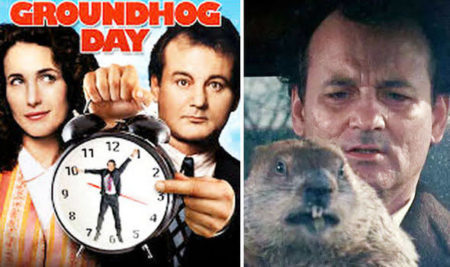Theme as the Controlling Idea
What is meant by the controlling idea in Stories?
 Controlling idea in Groundhog Day: Cynicism and selfishness give way to love and selflessness
Controlling idea in Groundhog Day: Cynicism and selfishness give way to love and selflessnessA story typically comprises of a sequence of linked events, centering on a protagonist who pursues a difficult goal against a rising tide of obstacles orchestrated by the antagonist, (or antagonistic forces). In achieving the goal, the protagonist has to overcome an inner weakness or limitation, which results in his/her becoming a wiser and more accomplished person.
But how do we, as writers, select the most appropriate incidents to relate? Certainly, verisimilitude, suspense, drama, excitement, and uniqueness play a role. But how do we choose between two actions of equal weight, in terms of this list? One way is to let the theme or controlling idea guide us.
In his book, Story, Robert McKee defines the theme, or controlling idea, as he prefers to call it, as a statement expressed in a single sentence that describes how and why life undergoes a change in value by the end of a story.
McKee explains that the controlling idea has two components: value and cause.
The controlling idea identifies the change from a positive to a negative value (or vice versa) at the story-climax as a result of the protagonist’s final action, and provides the main reason for this change.
Value plus cause, McKee informs us, captures the meaning of the story.
Value is the positive or negative charge found at the end of the story. In an up-ending, good triumphs, as in Groundhog Day, where cynicism and selfishness give way to love and selflessness; in a down-ending, negative values prevail. In Dangerous Liaisons, passion turns into self-loathing, resulting in hatred that destroys.
Cause, on the other hand, provides the reason why the protagonist’s world has been transformed into a positive or negative value. In writing a story, we work back from the end value, to the beginning, and trace the causes within the character, society, or environment that has brought about this change.
In Peter Falk’s Columbo, for example, we track back from the theme or controlling idea — Justice is done because the protagonist is cleverer than the criminal — selecting for inclusion only those story beats that serve the theme.
Sherlock Holmes style scenes in which Columbo uses deductive reasoning to corner the criminal are appropriate for a man of superior intelligence and observation skills. Reaching under his raincoat for a .44 Magnum in order to frighten the criminal into confessing, or beating the daylights out of him, is not, although it is a fitting action for Clint Eastwood’s Dirty Harry.
Summary
The theme or controlling idea encompasses a change in value plus the reasons for it. Keeping the theme foremost in our minds assists us in writing appropriate scenes that stay on track.
Tweet
The post Theme as the Controlling Idea appeared first on Stavros Halvatzis Ph.D..



